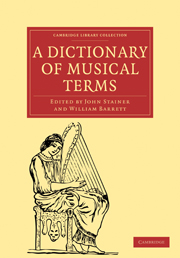E
Published online by Cambridge University Press: 10 November 2010
Summary
E.(1) The note Hypate in Greek music. [Greek music]
(2) The key-note of the Church mode called Phrygian.
(3) The note Elami in the system of Hexachords. [Notation.]
(4) The E above tenor C, the octave above it being represented by e, the octave below it by EE.
(5) The key having four sharps in its signature.
Ear. The Ear is the organ of hearing, in other words, the organ for the appreciation of sound, i.e., of vibrations of the air or water. All that is necessary to form an ear is a nervemass capable of appreciating these vibrations. Its simplest actual expression is a sac, filled with fluids, containing “otoliths”, (οὖς, ὼτὸς, an ear, and λίθος, a stone), and supplied with a nerve, a condition best exemplified in the sub-kingdom of Mollusca, represented familiarly by the oysters, the mussels, snails both terrestrial and aquatic, and the octopus. The “otoliths” are masses of carbonate of lime, as may readily be seen by placing one of them dissected out from any of the above mentioned animals (e.g. a snail) on a glass slide, covering it with an object glass with sufficient water to fill the interspace between the two, and adding at the side of the covering-glass a drop of any acid (acetic acid, or indeed ordinary vinegar will do very well) while the experimenter observes it through the microscope. Air bubbles—really bubbles of carbonic acid gas—will be seen to pour out from the otolith, and when these have ceased, that body will have entirely disappeared.
- Type
- Chapter
- Information
- A Dictionary of Musical Terms , pp. 144 - 162Publisher: Cambridge University PressPrint publication year: 2009First published in: 1876



